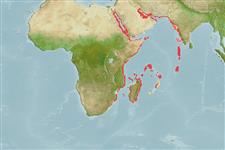Teleostei (teleosts) >
Eupercaria/misc (Various families in series Eupercaria) >
Scaridae (Parrotfishes) > Sparisomatinae
Etymology: Calotomus: Greek, kalos, kallos = beautiful + Greek, tomos = section, cut (Ref. 45335).
More on author: Rüppell.
Environment: milieu / climate zone / depth range / distribution range
Ecology
Marine; reef-associated; depth range 1 - 30 m (Ref. 9710). Tropical; 24°C - 26°C (Ref. 130607)
Western Indian Ocean: known only from the Red Sea, ranging from the Gulf of Aqaba to at least the coast of Ethiopia.
Size / Weight / Age
Maturity: Lm ? range ? - ? cm
Max length : 21.0 cm SL male/unsexed; (Ref. 3488)
Dorsal spines (total): 9; Dorsal soft rays (total): 10; Anal spines: 3; Anal soft rays: 9; Vertebrae: 25. Head and body gray-brown with darker scale edges, paler ventrally. Numerous dark spots on scales on operculum and region circumscribed by pectoral fin. Flexible dorsal spines; caudal fin rounded in juveniles, double emarginate in adults; pectoral fin base yellowish, the rest unpigmented; pale pelvic fins with 2 reddish bars, at the center and near the base. Skin dark, almost black around anus. Orangish iris.
Inhabits coral and rocky reefs and grass bed areas to depths of about 30 m (Ref. 9710). Occurs singly or in small groups (Ref. 9710). Feeds mainly on marine angiosperms and epiphytic algae. Caught mainly with traps, nets and other types of artisanal gear.
Life cycle and mating behavior
Maturity | Reproduction | Spawning | Eggs | Fecundity | Larvae
Bruce, R.W. and J.E. Randall, 1985. A revision of the Indo-West Pacific parrotfish genera Calotomus and Leptoscarus (Scaridae: Sparisomatinae). Indo-Pac. Fish. (5):32 p. (Ref. 525)
IUCN Red List Status (Ref. 130435: Version 2024-1)
Threat to humans
Harmless
Human uses
Fisheries: minor commercial; aquarium: commercial
Tools
Special reports
Download XML
Internet sources
Estimates based on models
Preferred temperature (Ref.
123201): 24.8 - 29.2, mean 27.5 °C (based on 233 cells).
Phylogenetic diversity index (Ref.
82804): PD
50 = 0.5312 [Uniqueness, from 0.5 = low to 2.0 = high].
Bayesian length-weight: a=0.02089 (0.00803 - 0.05439), b=2.98 (2.75 - 3.21), in cm total length, based on LWR estimates for this (Sub)family-body shape (Ref.
93245).
Trophic level (Ref.
69278): 2.0 ±0.00 se; based on food items.
Resilience (Ref.
120179): High, minimum population doubling time less than 15 months (Preliminary K or Fecundity.).
Fishing Vulnerability (Ref.
59153): Low vulnerability (16 of 100).
Nutrients (Ref.
124155): Calcium = 52.4 [20.4, 149.7] mg/100g; Iron = 0.709 [0.277, 1.756] mg/100g; Protein = 18 [16, 20] %; Omega3 = 0.066 [0.029, 0.146] g/100g; Selenium = 13.2 [4.0, 39.6] μg/100g; VitaminA = 42.1 [9.8, 167.6] μg/100g; Zinc = 2.25 [1.06, 4.02] mg/100g (wet weight);
